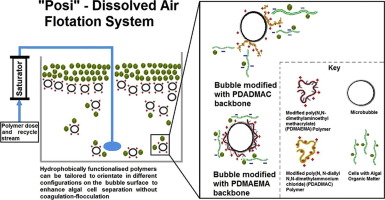Separation and Purification Technology ( IF 8.1 ) Pub Date : 2018-03-06 , DOI: 10.1016/j.seppur.2018.03.003 Narasinga Rao Hanumanth Rao , Anthony M. Granville , Christine I. Browne , Raymond R. Dagastine , Russell Yap , Bruce Jefferson , Rita K. Henderson

|
The novel dissolved air flotation (DAF) process that uses hydrophobically-modified polymers (HMPs) to generate positively charged bubbles (PosiDAF) has been shown to separate negatively charged algal cells without the need for coagulation-flocculation. Previous research has been limited to HMPs of poly(N,N-dimethylaminoethyl methacrylate) (PDMAEMA) and, while they were effective at bench-scale, performance at pilot-scale was better using commercial poly(N,N-diallyl-N,N-dimethylammonium chloride) (PDADMAC). Hence, the aim of this research was to compare the effectiveness of PDADMAC modified with aliphatic and aromatic moieties in comparison to previously tested PDMAEMA HMPs in respect to algal cell separation and minimisation of effluent polymer concentration, as well as defining the underlying polymer-bubble interaction mechanisms. Polymer-bubble adhesion properties were measured using atomic force microscopy (AFM) while polymer concentration was monitored via zeta potential and, where possible, assays using fluorescence spectroscopy. Both PDADMAC functionalised with a fluorinated aromatic group (PDADMAC-BCF) and PDMAEMA modified with 1-bromodecane respectively, gave effective cell separation, while the treated effluent zeta potential values at maximum cell removal were lower than the other polymers trialled. The effluent polymer concentration when using PDADMAC-BCF was four times lower in comparison to another aromatically modified PDADMAC polymer. AFM studies indicated that, in contrast to the PDMAEMA-based polymers, the PDADMAC-based polymers did not adsorb closely to the bubble surface. The different polymer-bubble interactions indicate that separation mechanisms will also vary, potentially leading to differences in process effectiveness when explored at pilot scale.
中文翻译:

使用新型“ Posi”溶解气浮工艺确定聚合物-气泡相互作用如何影响藻类分离
已显示使用疏水改性的聚合物(HMP)生成带正电的气泡(PosiDAF)的新型溶解气浮(DAF)工艺可分离带负电的藻类细胞,而无需进行絮凝絮凝。先前的研究仅限于聚甲基丙烯酸N,N-二甲基氨基乙基酯(PDMAEMA)的HMP,尽管它们在基准规模上是有效的,但使用商业化的聚(N,N-二烯丙基-N, N-二甲基氯化铵(PDADMAC)。因此,本研究的目的是比较用脂肪族和芳香族部分改性的PDADMAC与先前测试的PDMAEMA HMP在藻类细胞分离和废水聚合物浓度最小化以及定义潜在的聚合物-泡沫相互作用方面的有效性。机制。使用原子力显微镜(AFM)测量聚合物气泡的粘附性能,同时通过zeta电位监测聚合物浓度,并在可能的情况下使用荧光光谱法进行监测。用氟化芳族基团官能化的PDADMAC(PDADMAC-BCF)和用1-溴代甘蔗修饰的PDMAEMA均能有效分离细胞,而在最大去除率下处理后的出水Zeta电位值低于其他试验聚合物。使用PDADMAC-BCF时,流出的聚合物浓度比另一种芳族改性的PDADMAC聚合物低四倍。原子力显微镜研究表明,与基于PDMAEMA的聚合物相反,基于PDADMAC的聚合物并未紧密吸附到气泡表面。











































 京公网安备 11010802027423号
京公网安备 11010802027423号